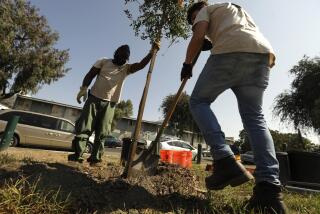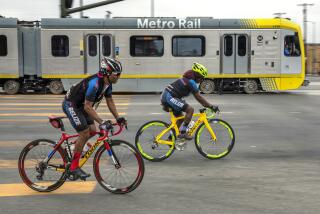A City That Would Love to Have Less Impact
- Share via
At the Santa Monica Festival on Saturday, the city’s eco-credentials were on full display.
Children had a chance to operate the controls of a municipal recycling truck. Their parents could attend a seminar titled “Demystifying Recycling.” There was information about energy-saving lightbulbs, community gardens -- and a novel approach to calculating how much of the Earth’s natural resources one person uses.
The Ecological Footprint, a tool developed by the nonprofit public policy group Redefining Progress, is being used by city officials to evaluate their use of the planet’s resources and educate residents about factors such as land use, transit, waste and recycling. It measures the impact individuals have on the planet by calculating how much land it takes to provide them with such things as food, energy and other resources. The result, determined by a computer program, is called a footprint. Each person should ideally have a footprint of 4.5 acres, which is how much land can be spared on the crowded planet to supply his or her needs.
A person or community determines a footprint by inputting such variables as amount of fuel used, the type of food eaten, commuting lengths, reliance on public transportation and use of energy-efficient appliances.
The average Santa Monican needs 20.5 acres, which is below the national average of 24.
“We in Santa Monica are using more than our fair share,” said Dean Kubani, a senior environmental analyst for the city whose own footprint is an enviable 9 acres. “We want to get people to ask, ‘What can we do to make our footprint smaller?’ ”
As he spoke, visitors to the booth sat down in front of a bank of computers and received a rundown on whether their level of consumerism is sustainable. They were greeted by Redefining Progress’ senior research associate, Jason Venetoulis. “Last time I checked, I think my footprint was 11 acres. But since then, I’ve taken a couple of trips,” he admitted sheepishly, worried about fossil fuel emissions.
As Venetoulis walked Kerry Candaele and his two daughters, Helena and Camille, through the program, he launched into eco-speak, using terms like “fair Earth share” and “built space.” Helena, who was paying attention, stopped him. “What’s unsustainable?” she asked.
“Is there an easy way to explain that to a 7-year-old?” her father asked Venetoulis.
You can do it for a while, but you can’t keep doing it, Venetoulis told her. Like when a balloon has a hole in it -- you can try to put your finger on the hole, but eventually the balloon will deflate. That’s the way our natural resources work.
He set Candaele up in front of a computer to work his way through a list of 20 questions on everything from the number of times he eats meat in a week to the weather in his hometown.
Within a few minutes, they had the verdict: Candaele’s footprint was 24 acres. If everyone on Earth had that result, the program told him, we’d need five planets.
“That’s not too good,” Candaele said. “It’s wasteful.”
Venetoulis printed Candaele’s results onto a sticker, which he suggested he wear on his chest.
“Why would I wear this?” Candaele asked Venetoulis. “It’s embarrassing.”
Both Venetoulis and Kubani shared ways to bring the number down: rarely eating meat, buying local produce, using energy-efficient bulbs and appliances, and driving more fuel-efficient cars. Or, better yet, not driving at all.
So far, in Santa Monica at least, it seems to be working. The city announced last month that it had shrunk its footprint by 5.7% between 1990 and 2000.
Still, the 8.3-square-mile city has a footprint of 2,747 square miles, according to its calculation, a swath that would take in most of Southern California.
But Kubani was optimistic. “The message we are trying to get across,” he said, “is that there are simple things to do to live within the Earth’s resources.”
The Ecological Footprint, he said, “gets people asking the questions.”


